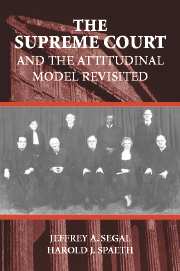Book contents
- Frontmatter
- Contents
- List of Illustrations
- List of Tables
- Preface
- 1 Introduction: Supreme Court Policy Making
- 2 Models of Decision Making: The Legal Model
- 3 Models of Decision Making: The Attitudinal and Rational Choice Models
- 4 A Political History of the Supreme Court
- 5 Staffing the Court
- 6 Getting into Court
- 7 The Decision on the Merits: The Legal Model
- 8 The Decision on the Merits: The Attitudinal and Rational Choice Models
- 9 Opinion Assignment and Opinion Coalitions
- 10 The Supreme Court and Constitutional Democracy
- 11 Conclusion
- Case Index
- General Index
2 - Models of Decision Making: The Legal Model
Published online by Cambridge University Press: 05 June 2012
- Frontmatter
- Contents
- List of Illustrations
- List of Tables
- Preface
- 1 Introduction: Supreme Court Policy Making
- 2 Models of Decision Making: The Legal Model
- 3 Models of Decision Making: The Attitudinal and Rational Choice Models
- 4 A Political History of the Supreme Court
- 5 Staffing the Court
- 6 Getting into Court
- 7 The Decision on the Merits: The Legal Model
- 8 The Decision on the Merits: The Attitudinal and Rational Choice Models
- 9 Opinion Assignment and Opinion Coalitions
- 10 The Supreme Court and Constitutional Democracy
- 11 Conclusion
- Case Index
- General Index
Summary
In the next two chapters, we present three distinct models of Supreme Court decision making: the legal model, the attitudinal model, and the rational choice model. While we apply these models throughout the text, we present the clearest tests of them in Chapters 7 and 8, which cover the decision on the merits.
ABOUT MODELS
Before discussing these models, it may be useful to discuss what a model is and why it is used. We start with the premise that the real world is extraordinarily complex. While natural phenomena may often reduce perfectly to formulae such as E = mc2, the causes of human behavior are typically much more complex and intermeshed. For example, why did the Court find for Roe and not Wade in its 1973 decision striking abortion laws? We readily imagine that we could write an entire book on why the justices did so. Following that, we could write a similar book about Brown v. Board of Education, Marbury v. Madison, or any number of similarly important cases. We expect that we would learn a lot in researching and writing such a book, and that readers might learn a bit in reading it.
This approach to learning, the case study approach, involves learning as much as possible about as little as possible. While one can profit from this sort of immersion in detail, several shortcomings result as well. First, the complexity of human behavior could occasion years of studying a particular decision and still not result in full comprehension.
- Type
- Chapter
- Information
- The Supreme Court and the Attitudinal Model Revisited , pp. 44 - 85Publisher: Cambridge University PressPrint publication year: 2002
- 1
- Cited by



